Learn about the dining culture of izakaya, also known as Japanese-tapas-style pubs, where frosty beer and sake, tasty bites, and jolly chatters are all part of the deal.
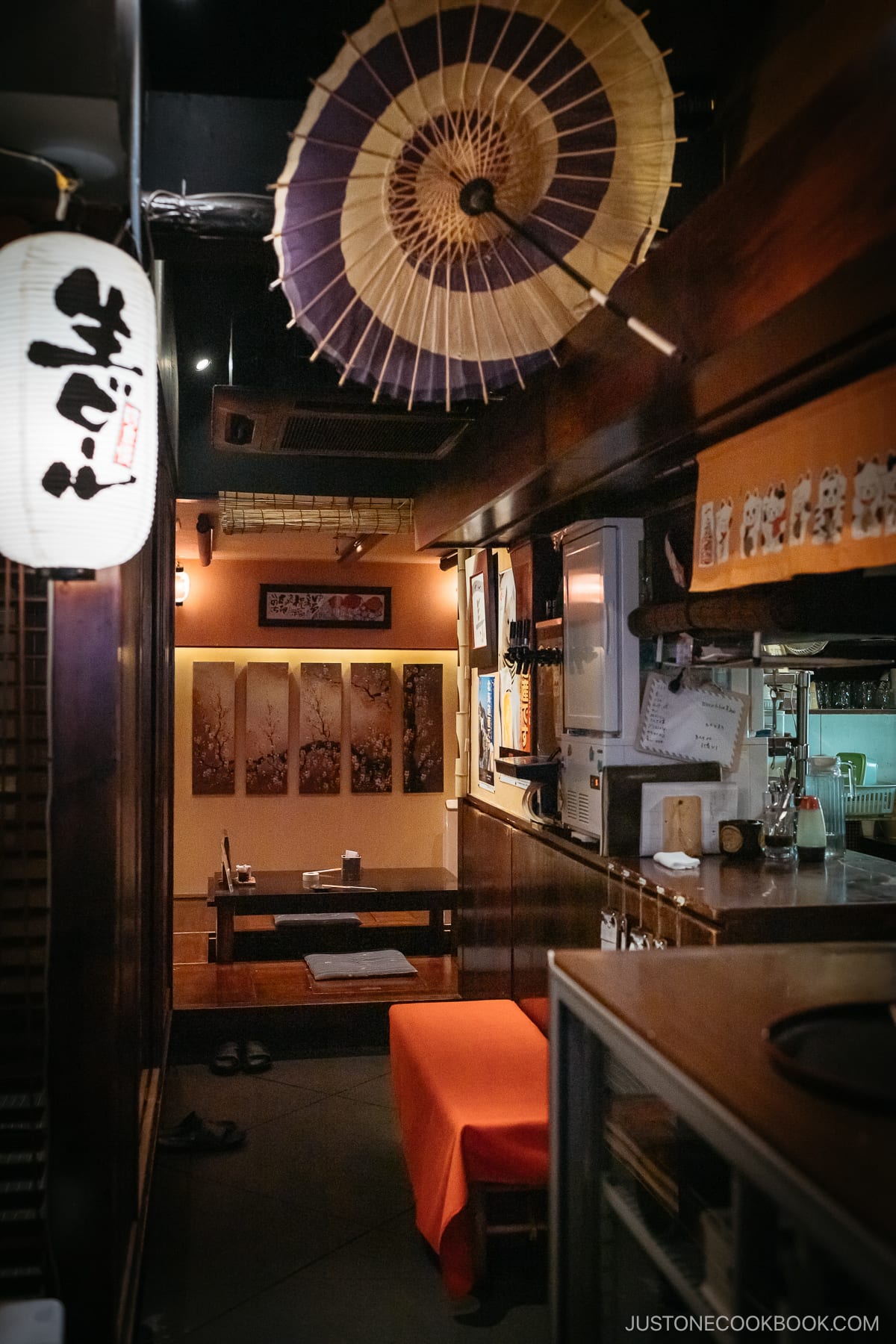
Izakaya (居酒屋), also known as Japanese gastropubs, are integral to Japanese social life and dining experience. It’s where people gather to unwind for drinks, small plates, and good company. Izakayas encourage a communal dining experience where family, friends, and colleagues share dishes, fostering a sense of togetherness and camaraderie.
The izakaya culture has also taken off outside Japan, spreading the love of good food and company. There’s no pressure to drink at an izakaya, so non-drinkers and diners of all ages are welcome!
Table of Contents
What is an Izakaya?
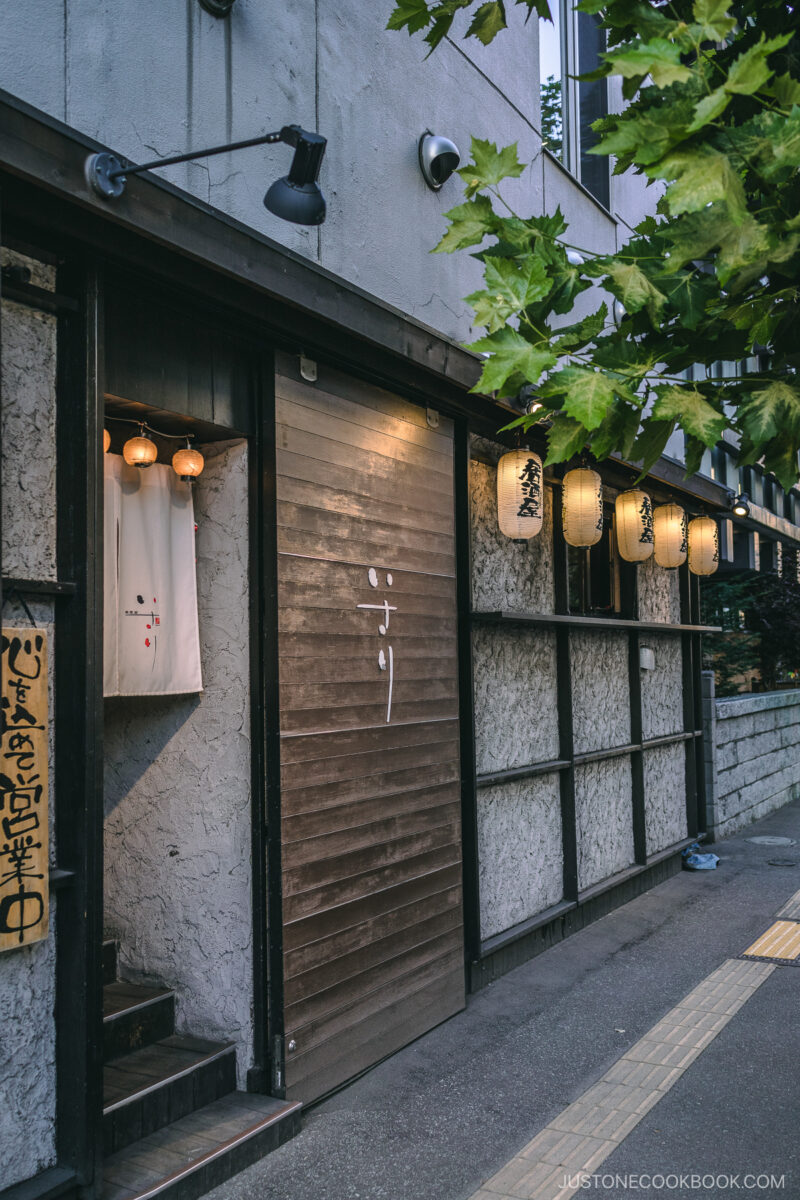
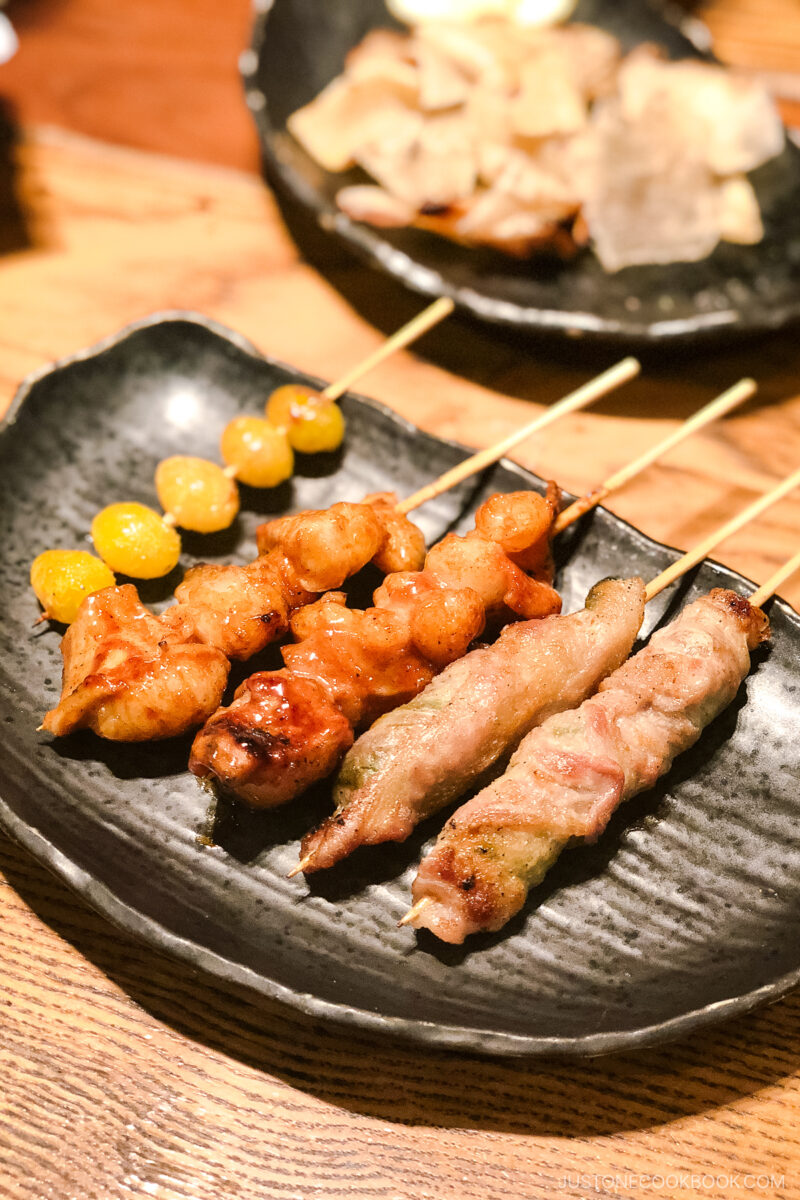
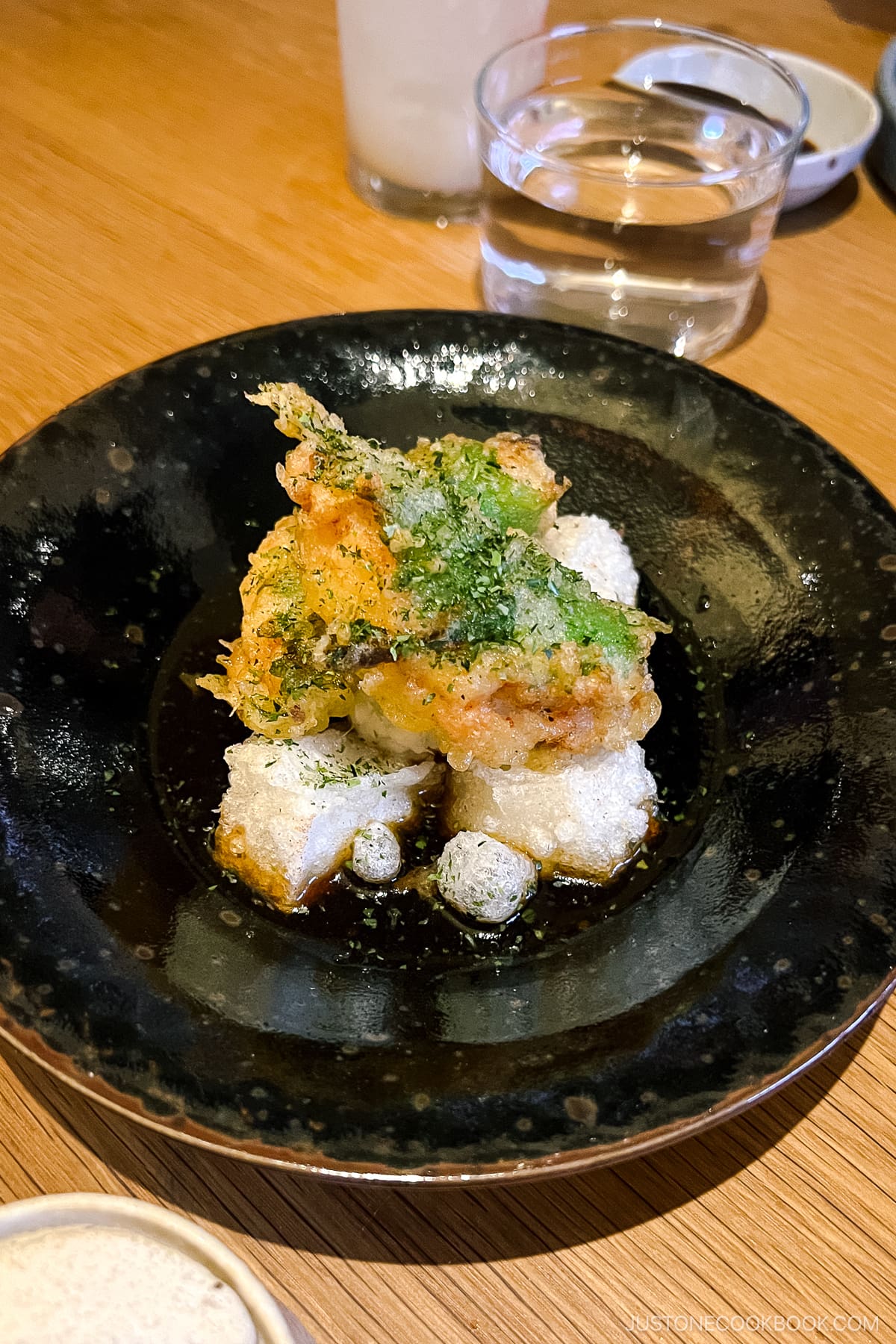
An izakaya is a Japanese pub or tavern where people gather for drinks and food and socialize in a relaxed and friendly atmosphere. The menu usually offers a range of traditional Japanese fare, fusion dishes, and international cuisines.
If you are traveling to Japan, I highly recommend visiting an izakaya to explore the Japanese eating and drinking culture. It can range from high-end to low, from hole-in-the-wall spots to massive chain establishments in all shapes and sizes. Adding an izakaya pit stop during your vacation might be a fun expedition!
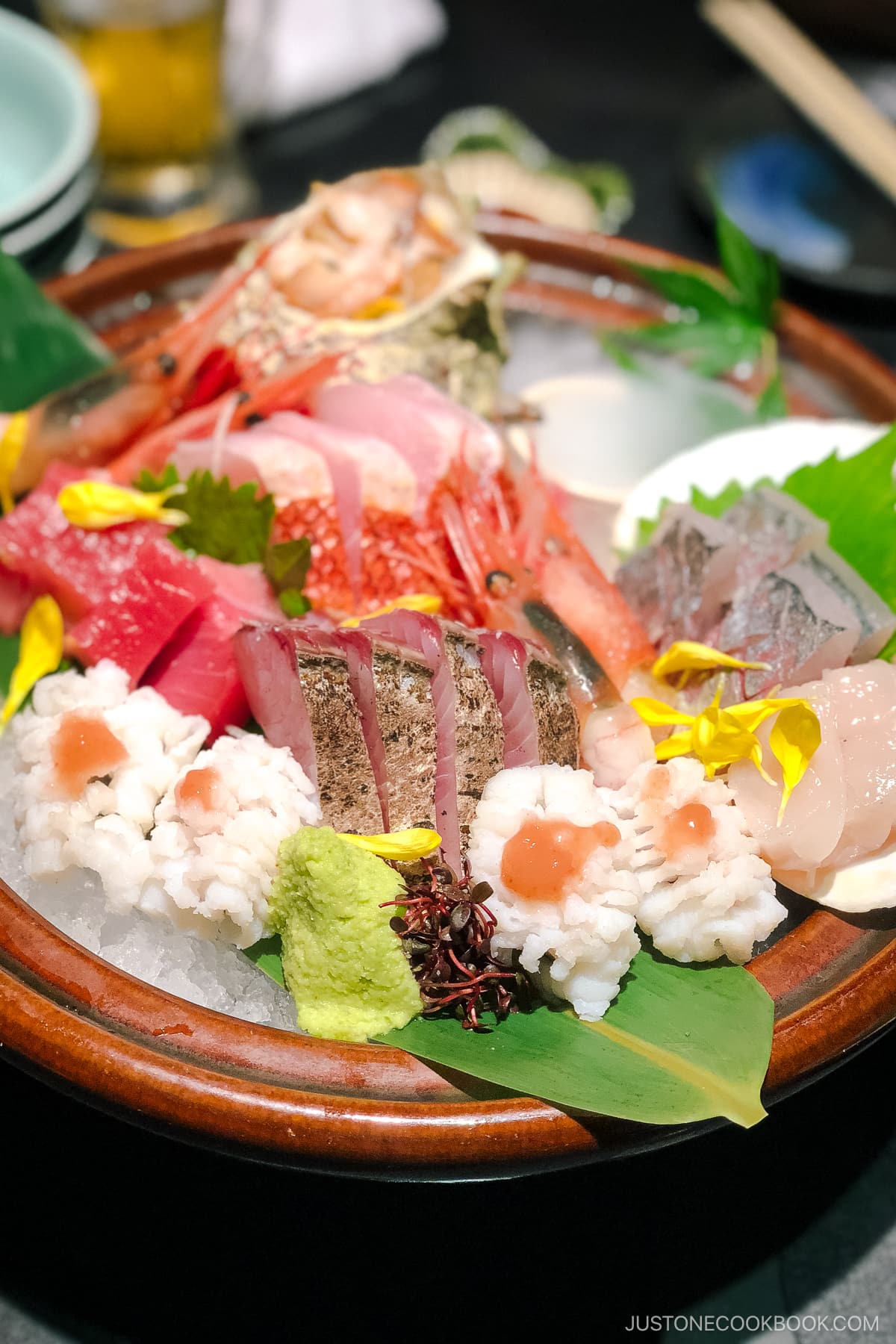
Historical Background of Izakaya
The term “izakaya” is a combination of “i” (居る “to stay”) and “sakaya” (酒屋 “sake shop”), which reflects the historical origin of these establishments. The roots trace back to the Edo period (1603-1868) when they were known as “sakaya” (sake shops). Customers would buy sake by the masu (升, square wooden measuring vessel) or bottle at the sakaya, and drink on-premise. To prolong their stay, sake merchants offered simple snacks and appetizers to accompany the sake.
Over time, the concept evolved into proper restaurant establishments, and izakayas started to offer a broader range of alcoholic beverages, including beer, shochu, whiskey, and cocktails, in addition to sake.
What to Eat and Drink at an Izakaya
Ready to explore the menu at an izakaya? Here’s a sample of dishes and drinks you may encounter. I’ve also added links to Nami’s recipes to recreate the izakaya experience at home without hopping on a plane!
Otoshi/Tsukidashi (お通し・突き出し)
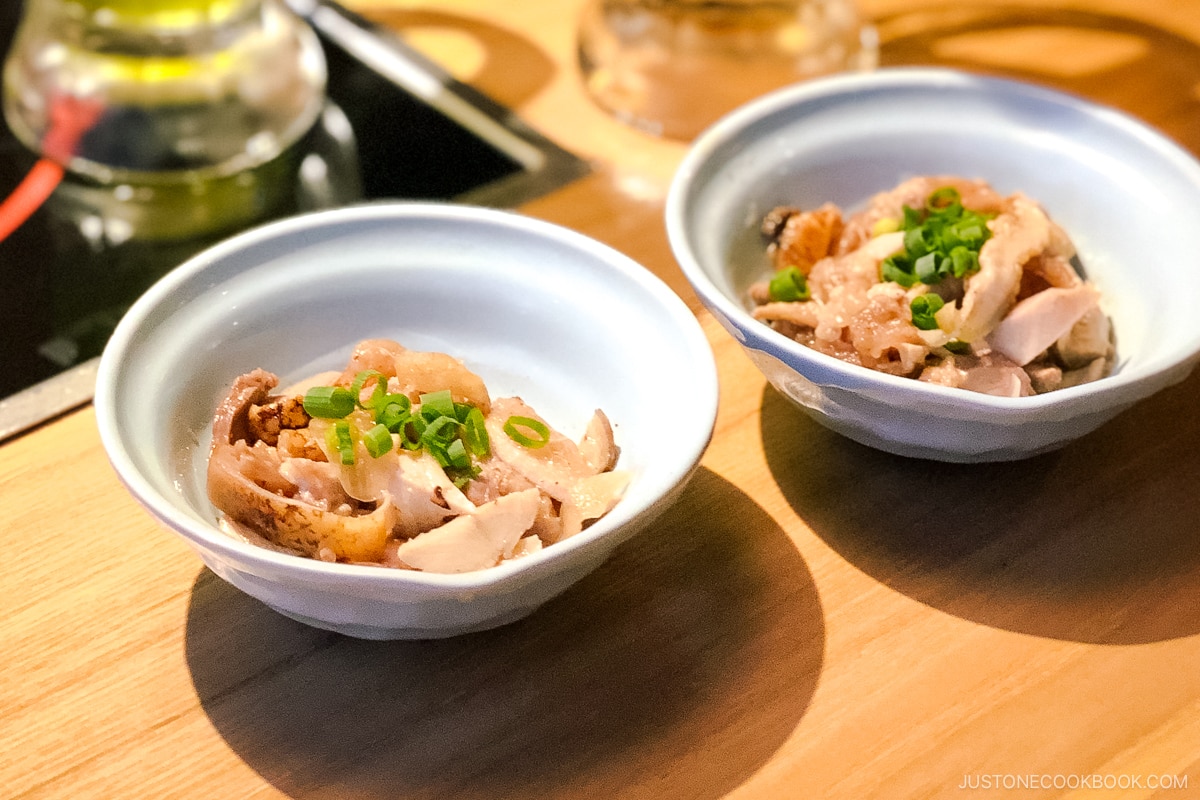
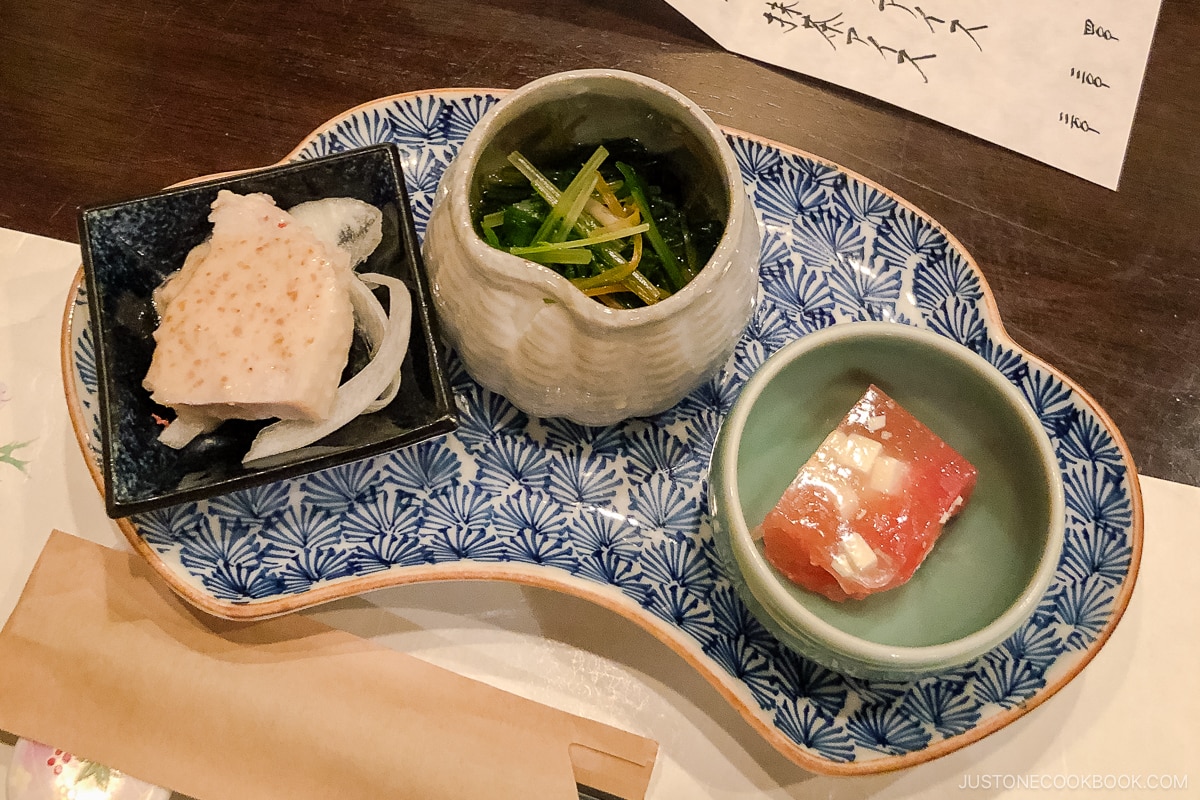
Otoshi (お通し) or tsukidashi (突き出し) is a table charge/cover charge. It usually entails a small appetizer or snack automatically served to customers when they sit down. It’s intended to whet the appetite while diners peruse the menu and wait for their order. It can vary by the establishment but expect to dish out a few hundred yen for the charge.
Unlike other menu items, diners do not have the option to choose what is served as the otoshi/tsukidashi. It is a predetermined dish offered by the restaurant for a fixed price. This practice is common in other traditional Japanese restaurants besides izakaya.
Not all izakayas implement the otoshi/tsukidashi system. If you are unsure, check with the staff before entering the restaurant or call in beforehand so you’re not surprised by the addition to your bill. Please do not challenge the fee unless you wish to be branded a stingy and difficult customer!
Otsumami (おつまみ)
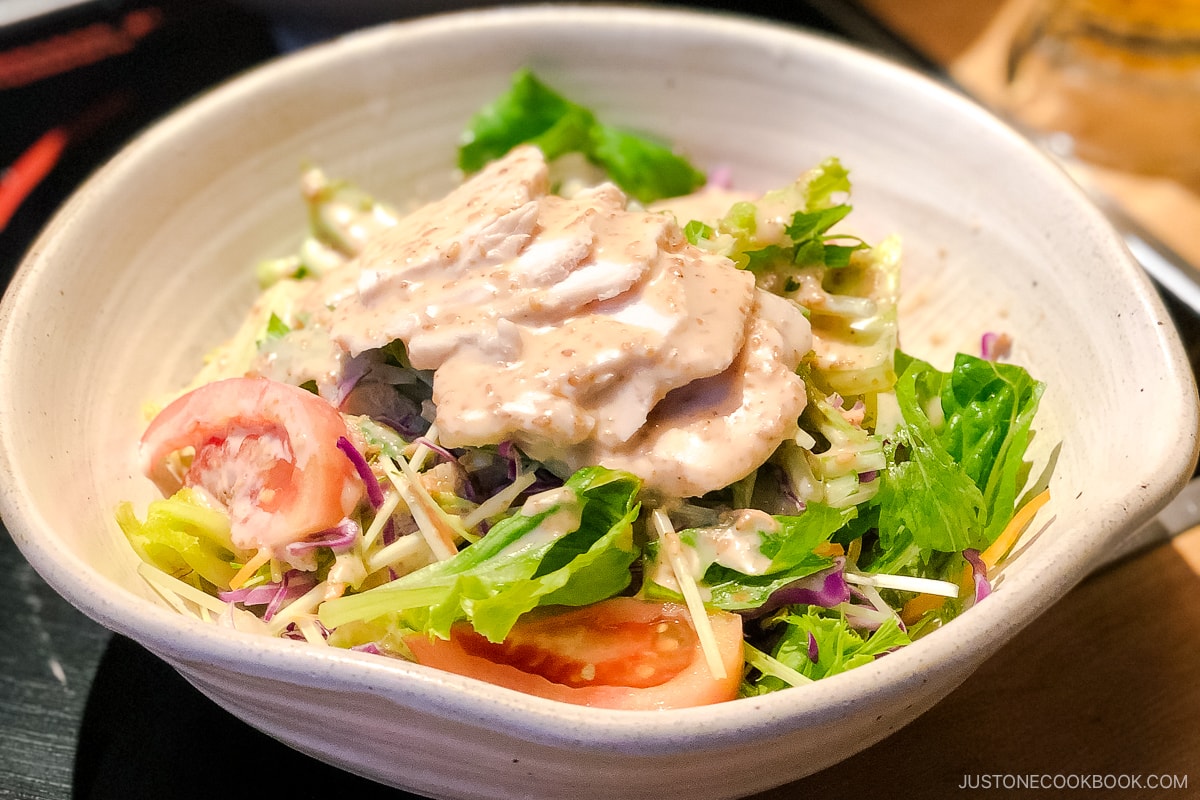
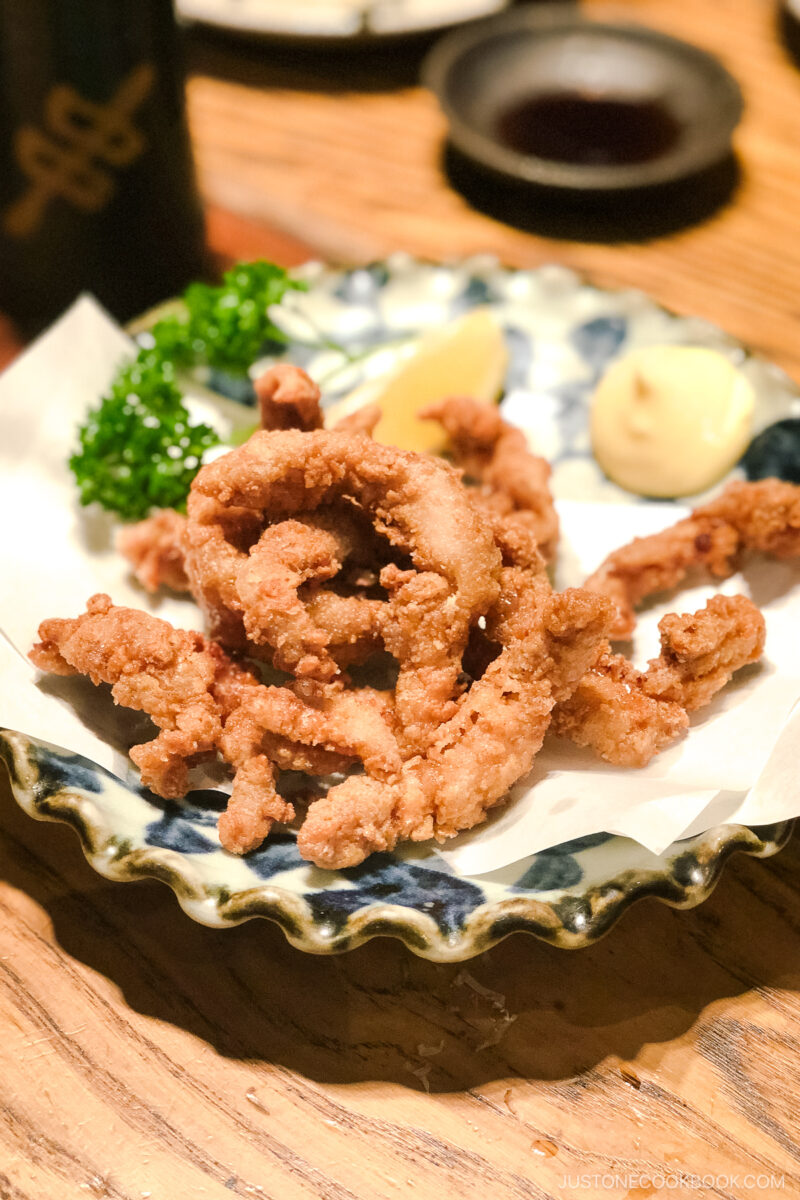
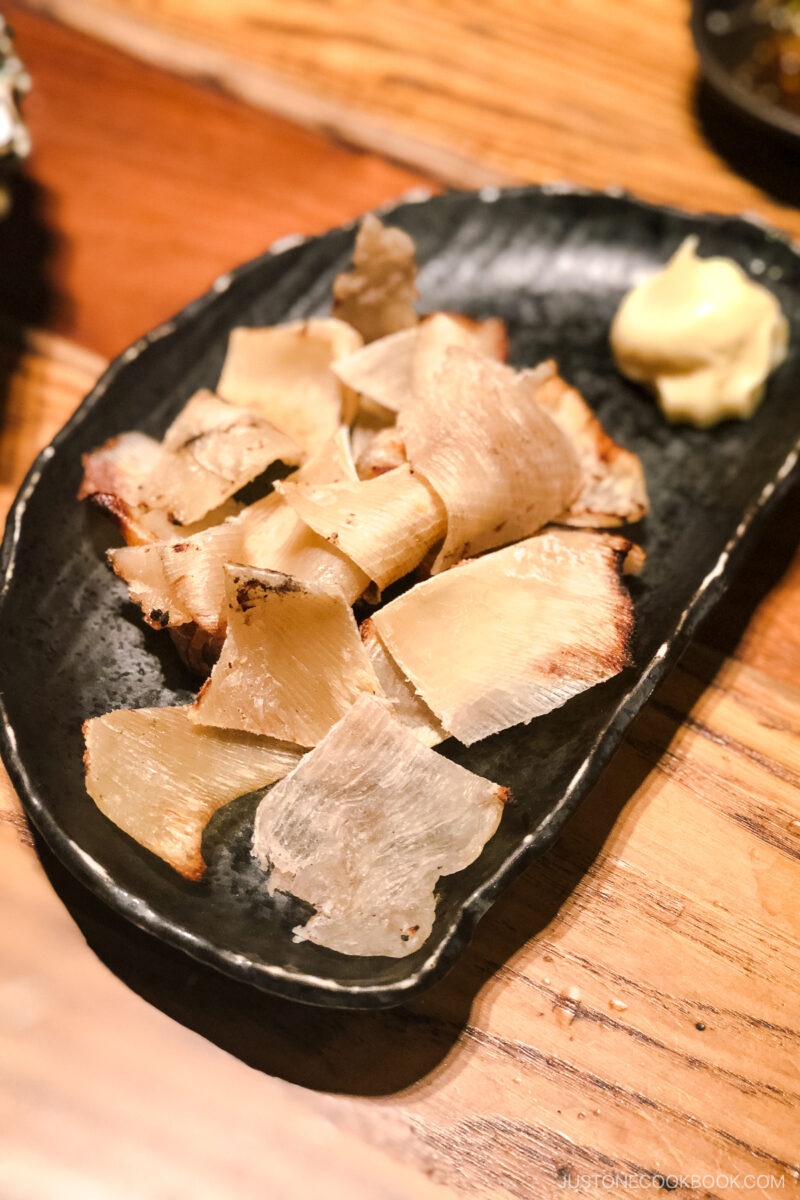
Start your izakaya experience with various hot or cold appetizers. This will help stimulate your hunger and get something into your system before the drinking begins. You’ll see classics such as deep-fried or chilled tofu, salads beyond leafy greens, and meat and seafood dishes in shareable portions.
🥗 Agedashi Tofu, Japanese Potato Salad, Harusame Salad, Spicy Edamame, Ankimo recipes on JOC.
Yakitori – Chicken Skewers (焼き鳥)
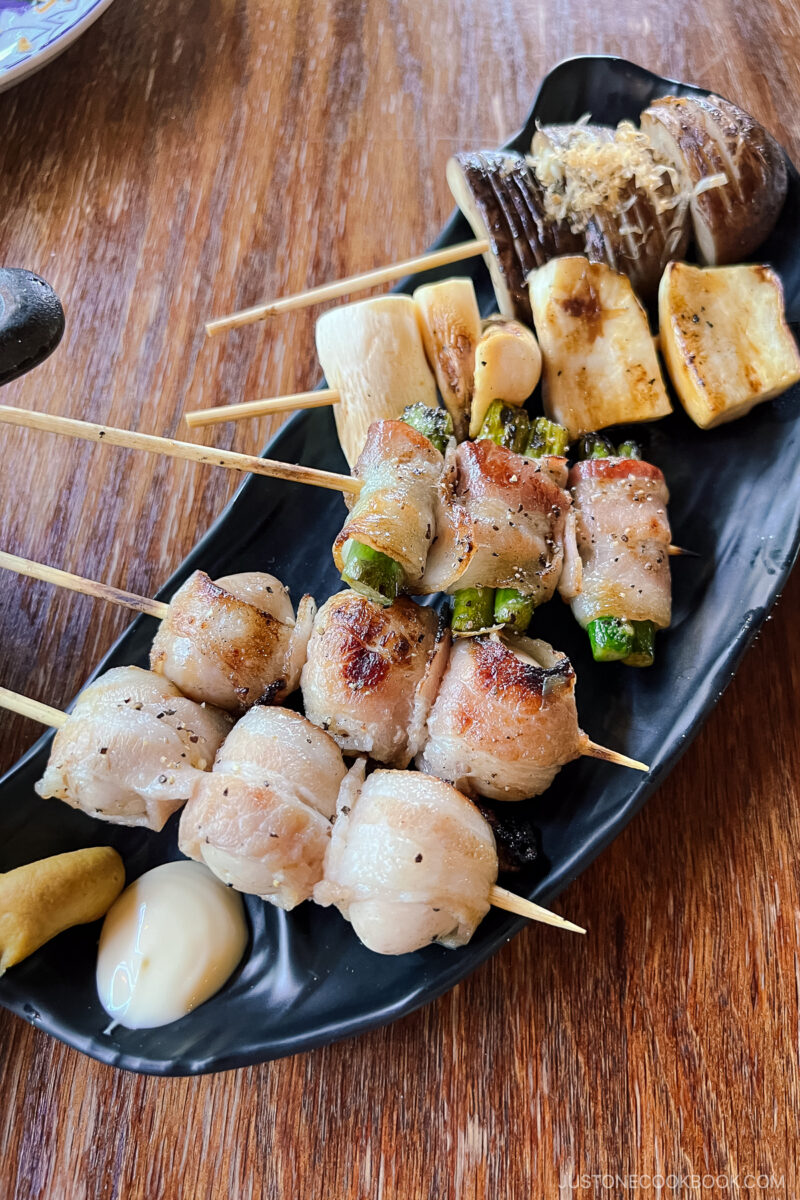
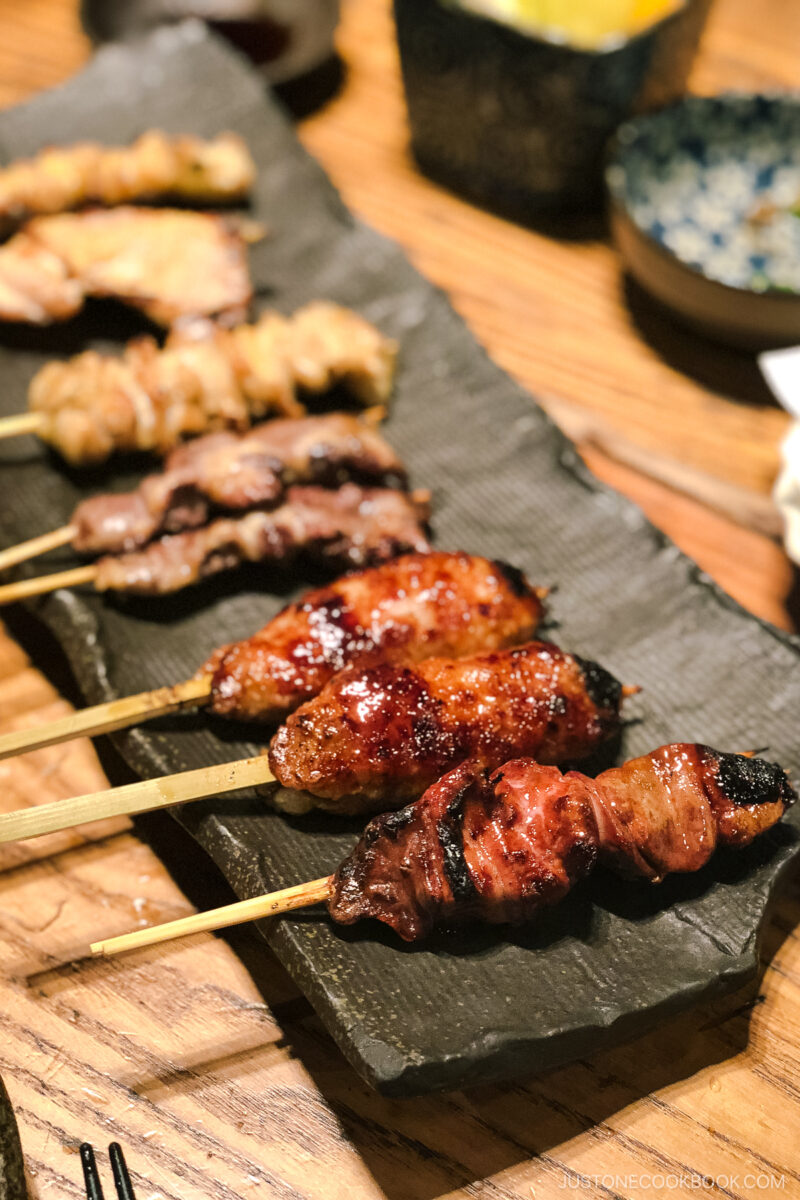
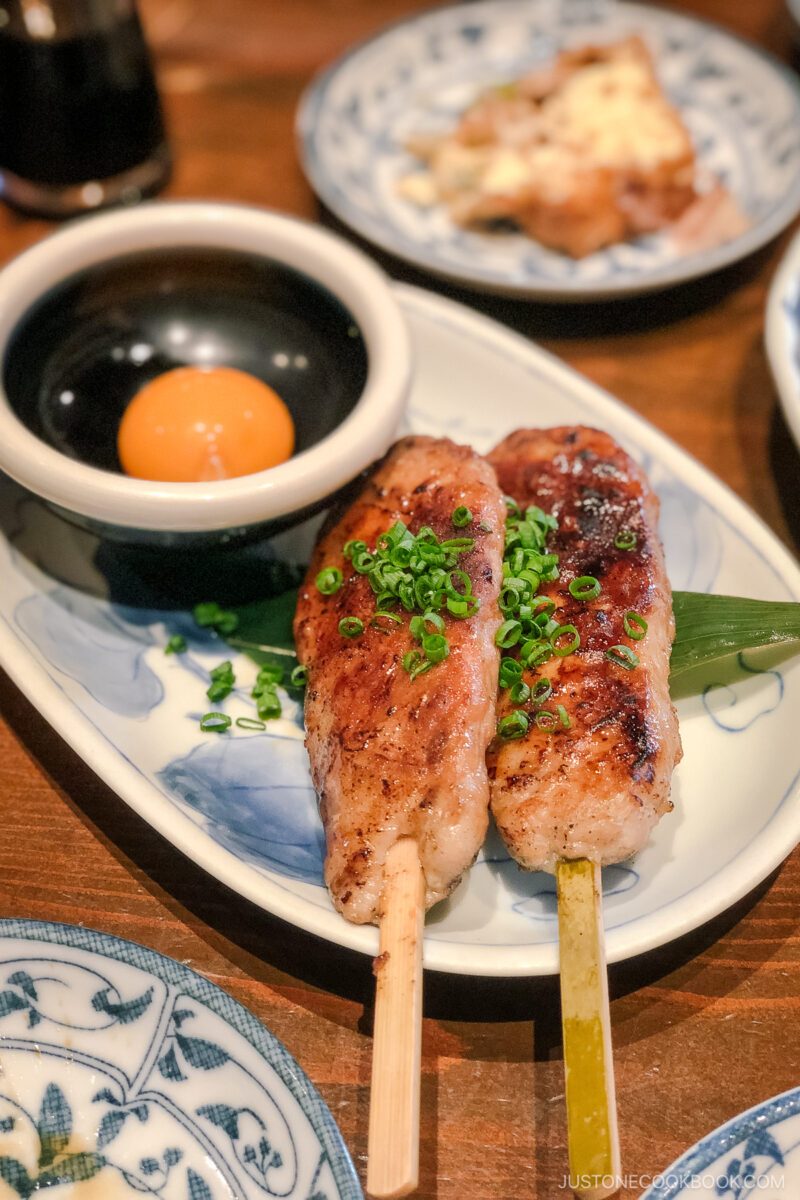
Yakitori (literally “grilled chicken”) is skewered chicken grilled over charcoal. It’s seasoned with salt or brushed with a sweet-salty tare sauce (a mixture of soy sauce, mirin, and sugar). You can choose from cuts of breasts, thighs, cartilage, wings, skins, tail meat, liver, heart, gizzards, and chicken patties (tsukune). It may be grilled with vegetables such as scallions, cherry tomatoes, shiitake, and shishito peppers.
🐓 Yakitori, Tsukune, and Yakitori-style Grilled Vegetable recipes on JOC.
Sashimi (お刺身)
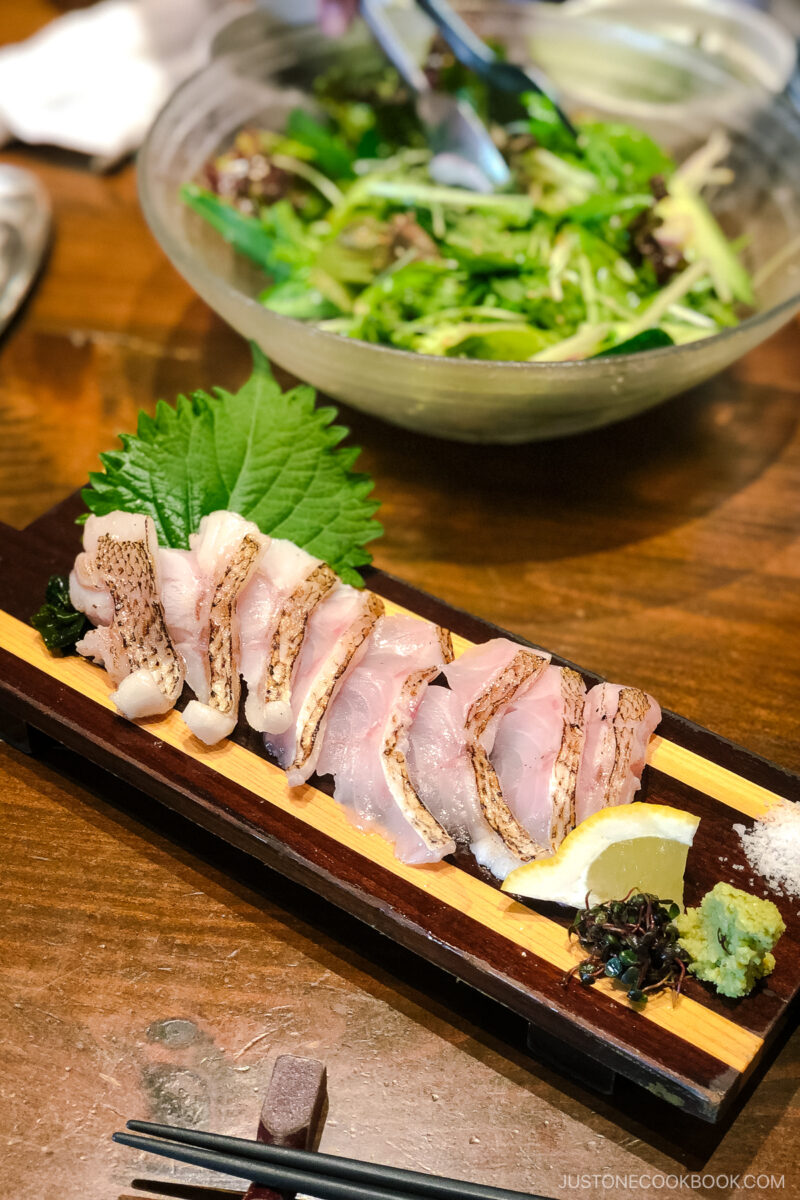
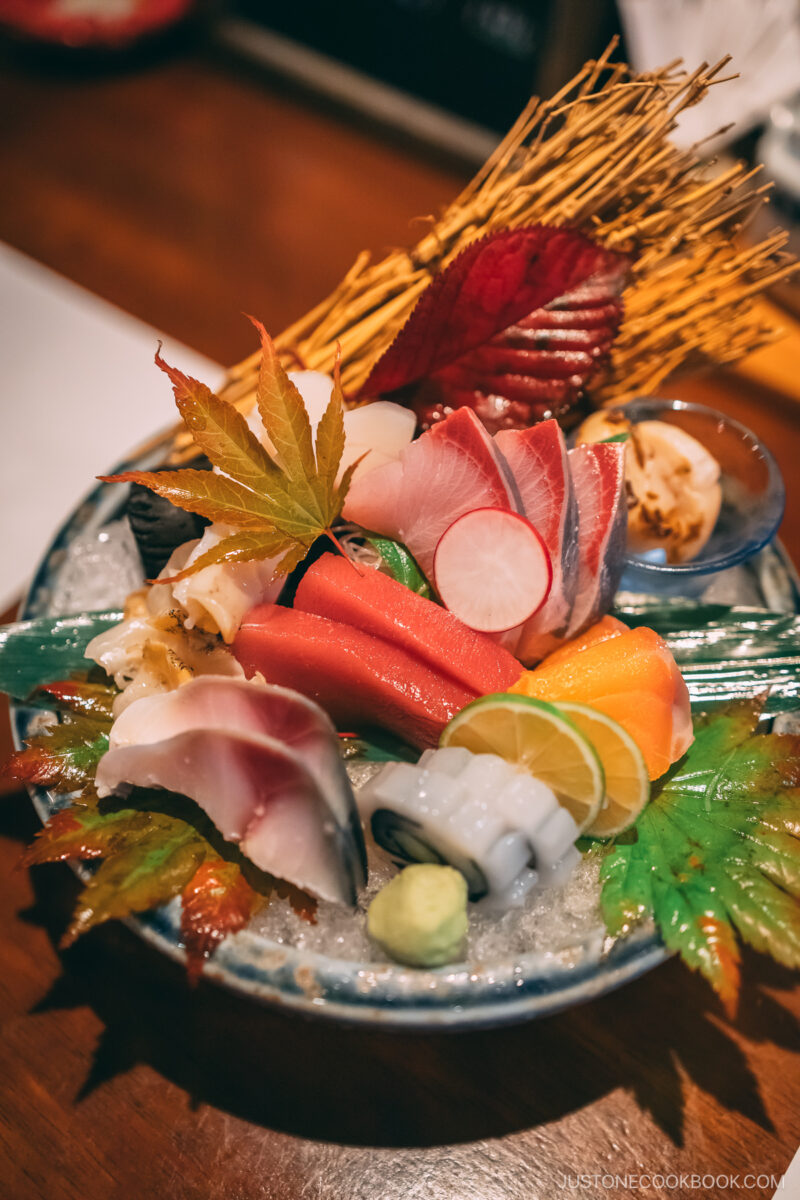
Sashimi (刺身) consists of thinly sliced raw fish or seafood served without rice. The term “sashimi” derives from sasu 刺す (to pierce) and mi 身 (body), referring to the way the fish or seafood is cut and presented for consumption.
Izakaya will typically serve a plate of sashimi featuring several fresh fish and seafood that you dip into soy sauce and wasabi or an already seasoned. It’s rare to see sushi on an izakaya menu as sushi making is a specialized skill that takes years, if not decades, to hone (also, the Japanese prefer to go to specialized restaurants for sushi, tempura, unagi, sukiyaki, etc).
🐟 Hamachi Crudo, Octopus Carpaccio, Garlic Soy Marinated Albacore, and Tuna Tataki recipes on JOC.
Grilled Fish (焼き魚)
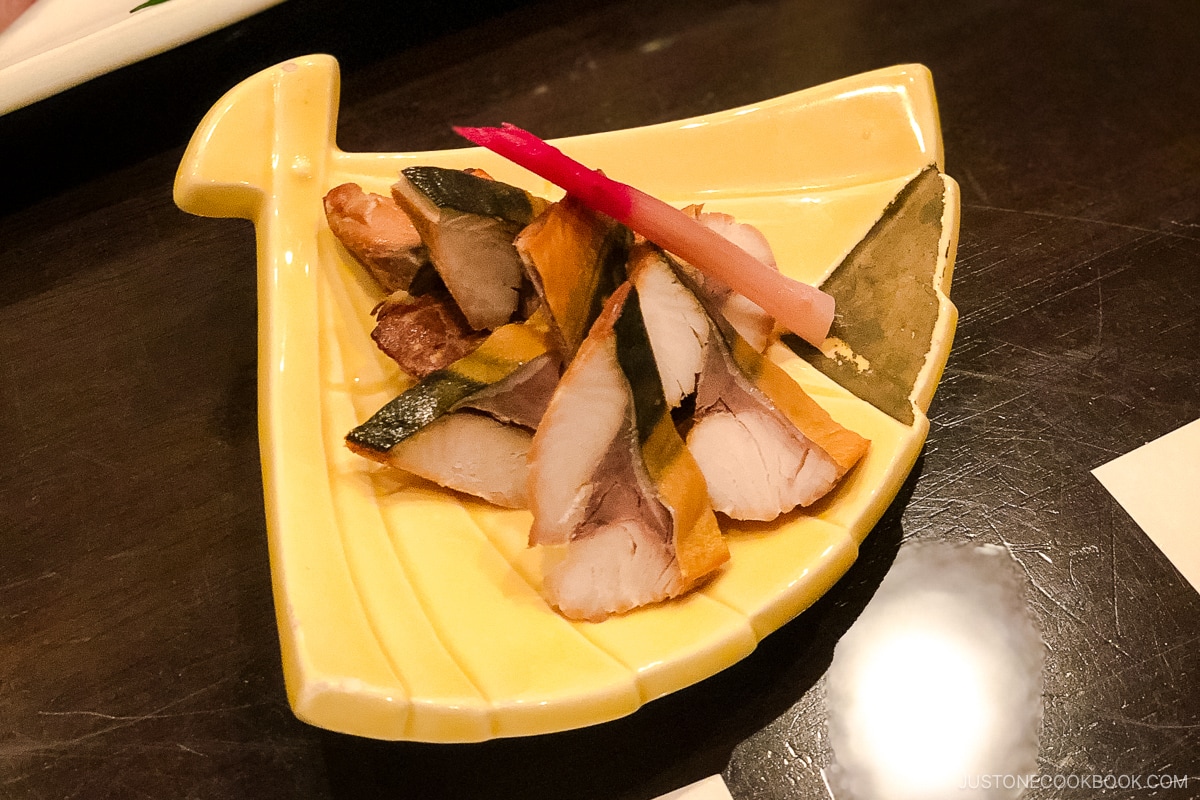
While the Japanese eat grilled fish at home, it’s common to see it on an izakaya menu. The selection may vary by seasonal availability or regional specialty. The menu may offer fish such as mackerel (saba 鯖), salmon (sake 鮭), sea bream (tai 鯛), yellowtail (hamachi/buri 鰤), and sardines (iwashi 鰯).
It may be seasoned with salt or marinated with miso, then grilled over an open flame or charcoal grill. This will result in a smoky and charred flavor to the fish. If the fish is whole, removing the skin and bones may be tricky with chopsticks.
🐠 Hamachi Kama, Grilled Mackerel, Sanma Shioyaki, and Miso Salmon on JOC.
Deep-fried Foods (揚げ物)

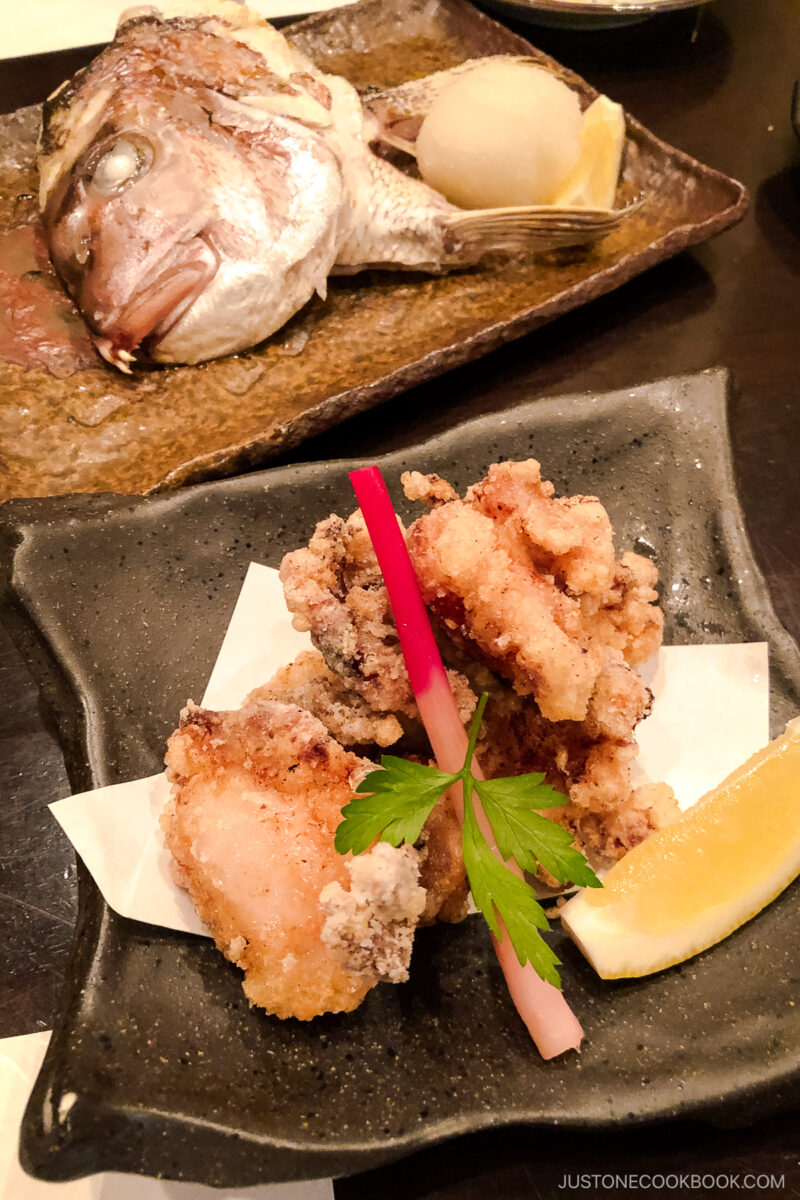
Who can resist a piping-hot display of deep-fried foods? From vegetables, meat, and seafood, these crunchy and flavorful delights will complement any drink, whether alcoholic or non-alcoholic.
You can expect a selection of deep-fried foods, also known as agemono (揚げ物, literally “deep-friend things”), such as tempura (天ぷら), furai (フライ), karaage (唐揚げ), katsu (カツ), and croquettes (コロッケ). Dip it into Japanese brown sauce, salt, or ketchup, and enjoy!
🍤 How to Make the Best Tempura, Karaage, Ham Katsu, Japanese Fried Oysters, and Chicken Cheese Katsu recipes on JOC.
Hot Pot and Oden (鍋物・おでん)
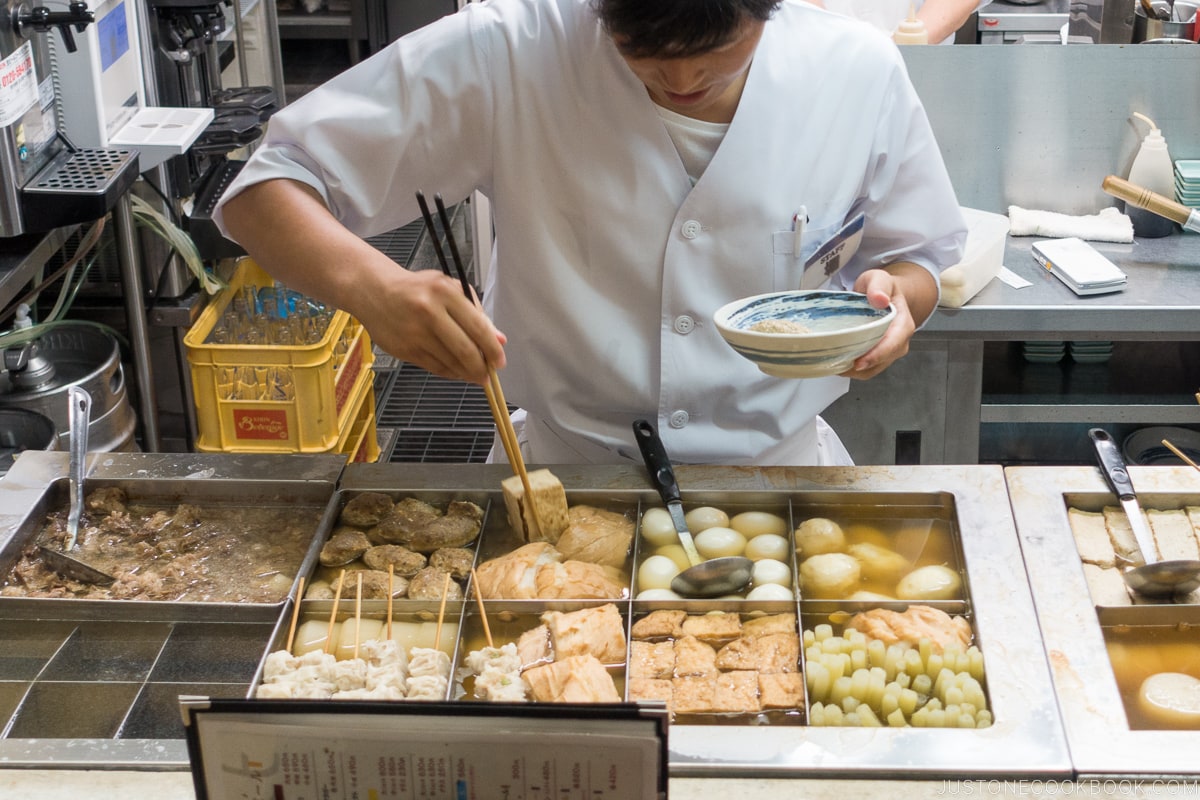
You may see hot pot dishes and oden on the menu during the chilly months of autumn and winter. It’s a quick and convenient way to warm up when it’s cold outside. Some izakaya will adjust the portion to your preference. So you can ask for a single portion or a big pot of nabe in a donabe clay pot bubbling at the table before you. For oden, you usually pick what you wish to order, such as daikon, fish cakes and balls, tofu, and hanpen.
🍢 Oden, Kimchi Gyoza Nabe, and Mizutaki recipes on JOC.
Rice and Noodles to Finish (締め)
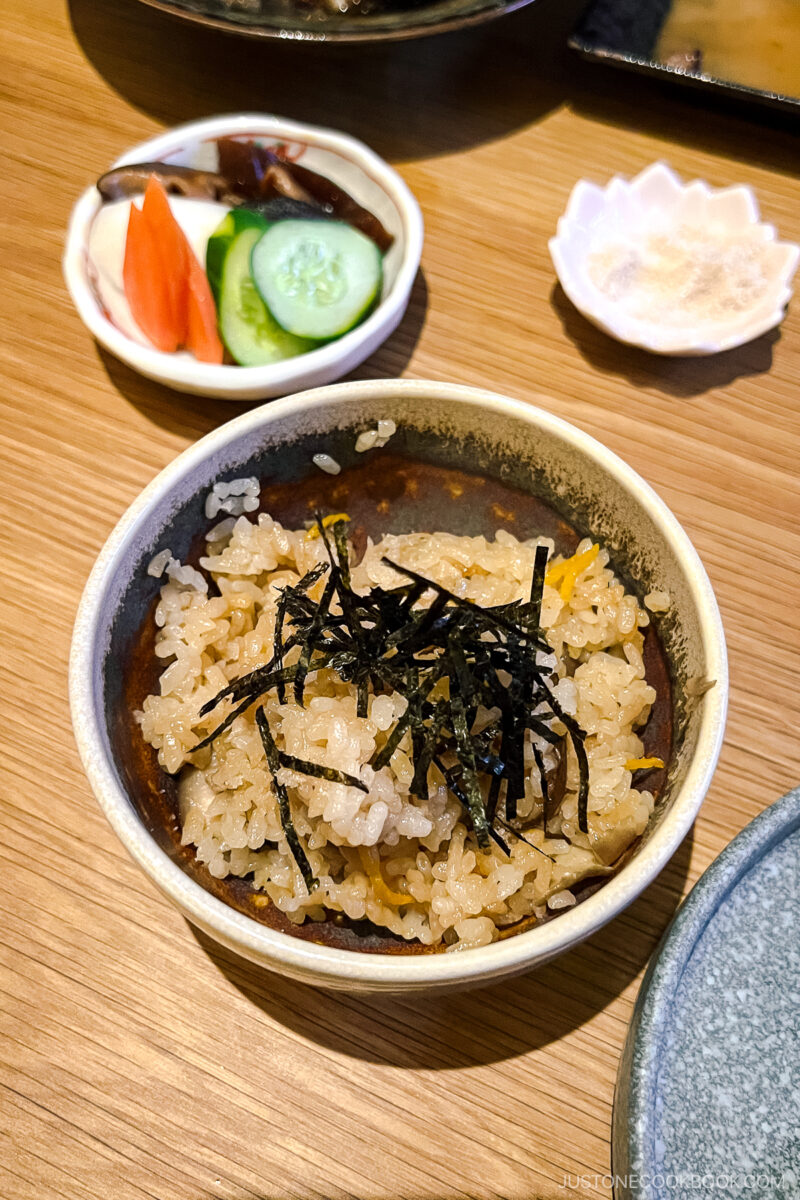
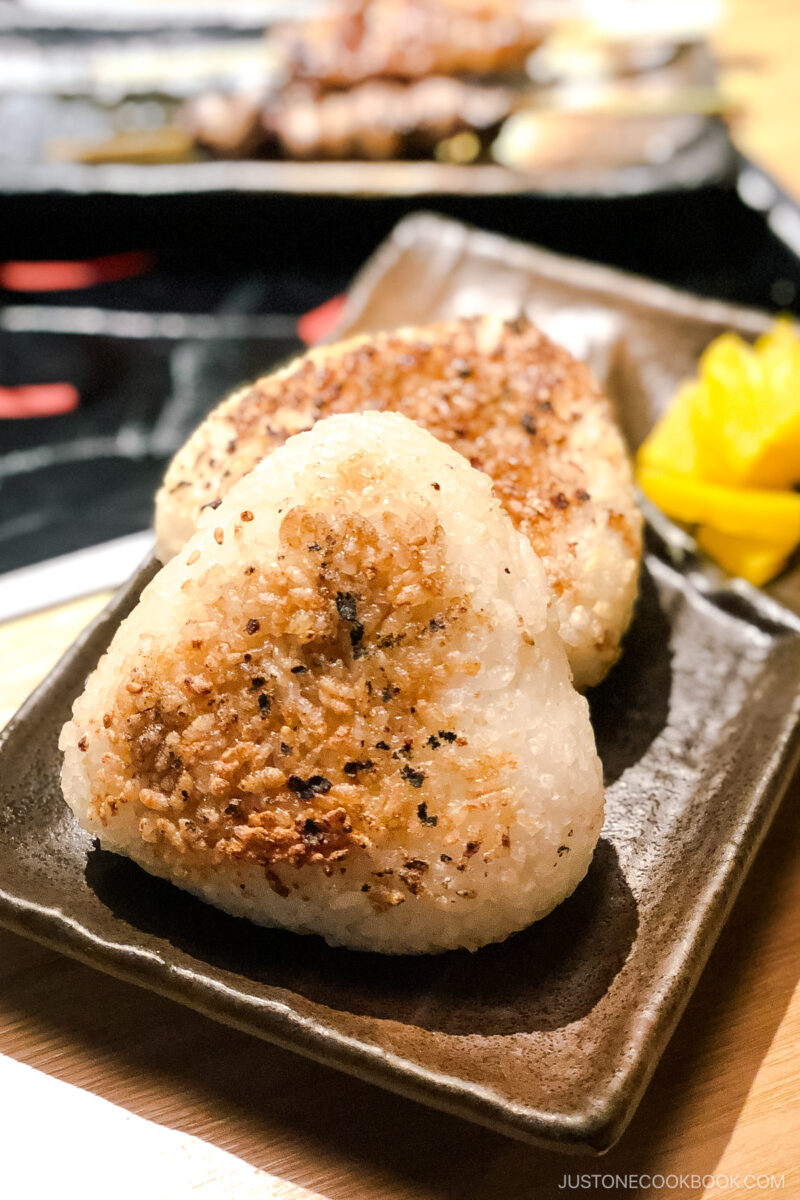
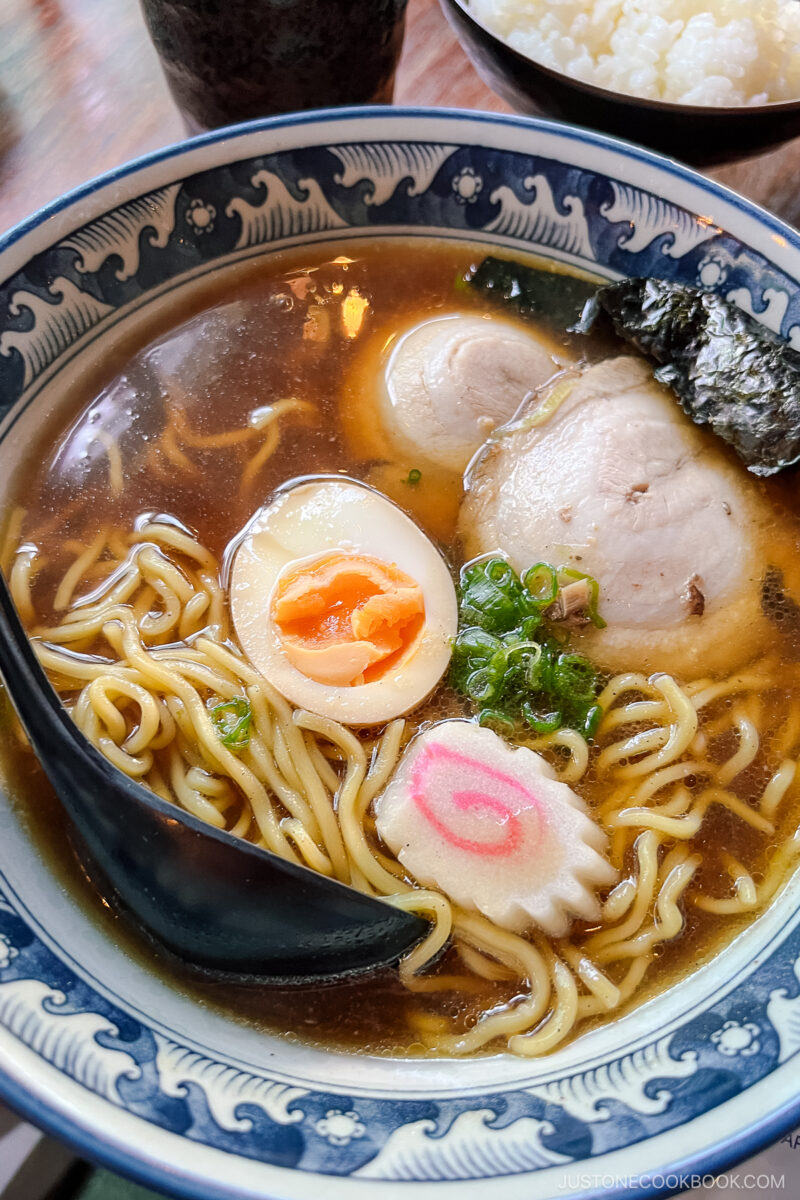
Ready to finish off the night? The Japanese usually finish their round of drinking with carbs in the form of rice or noodle dishes. You can go for a salty and hearty bowl of ramen or something lighter on the stomach, like ochazuke or udon noodles.
🍚 Ochazuke, Onigiri, Yakisoba, Shoyu Ramen, and Beef Udon recipes on JOC.
Alcoholic and Non-Alcoholic Drinks
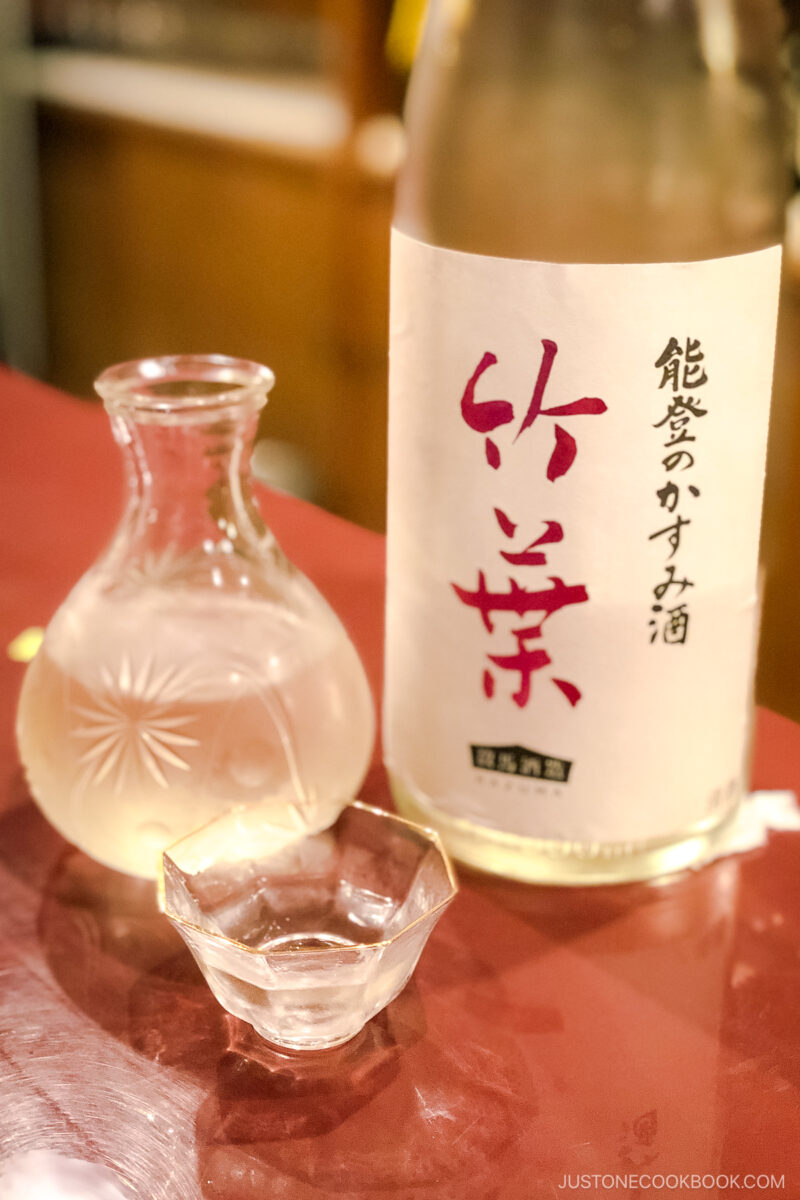
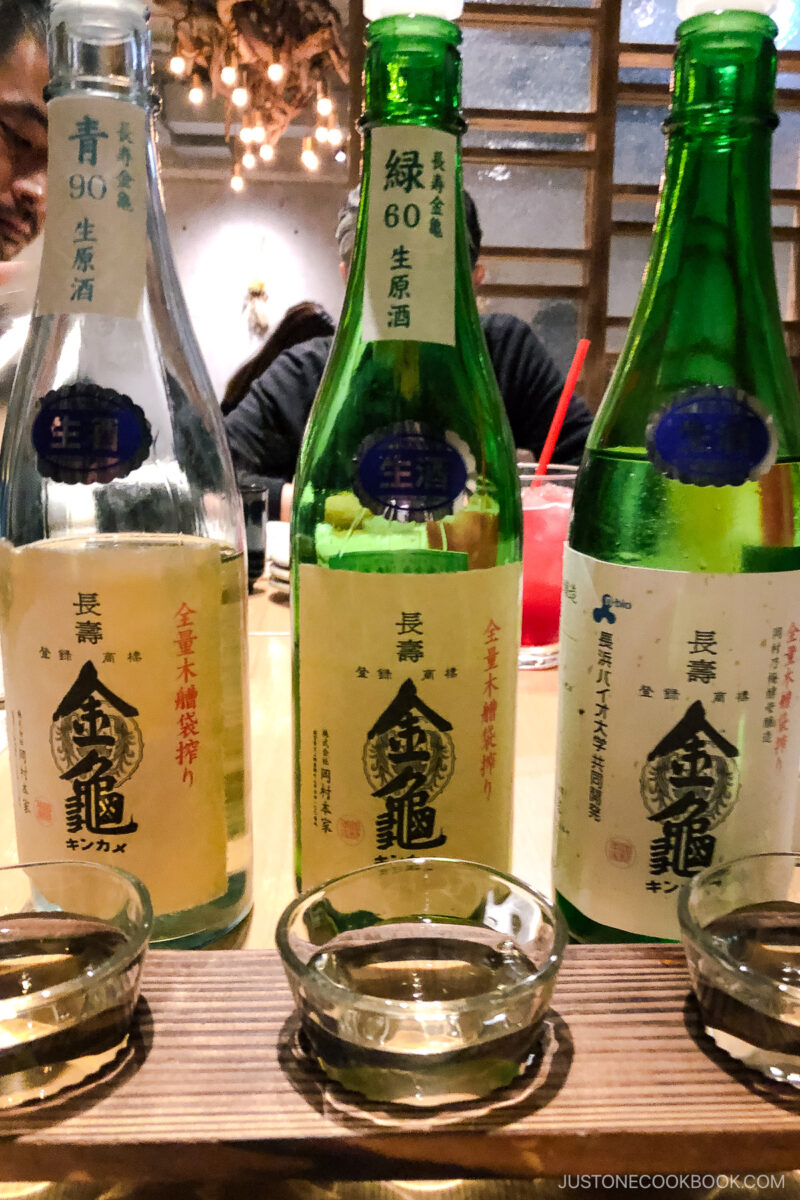
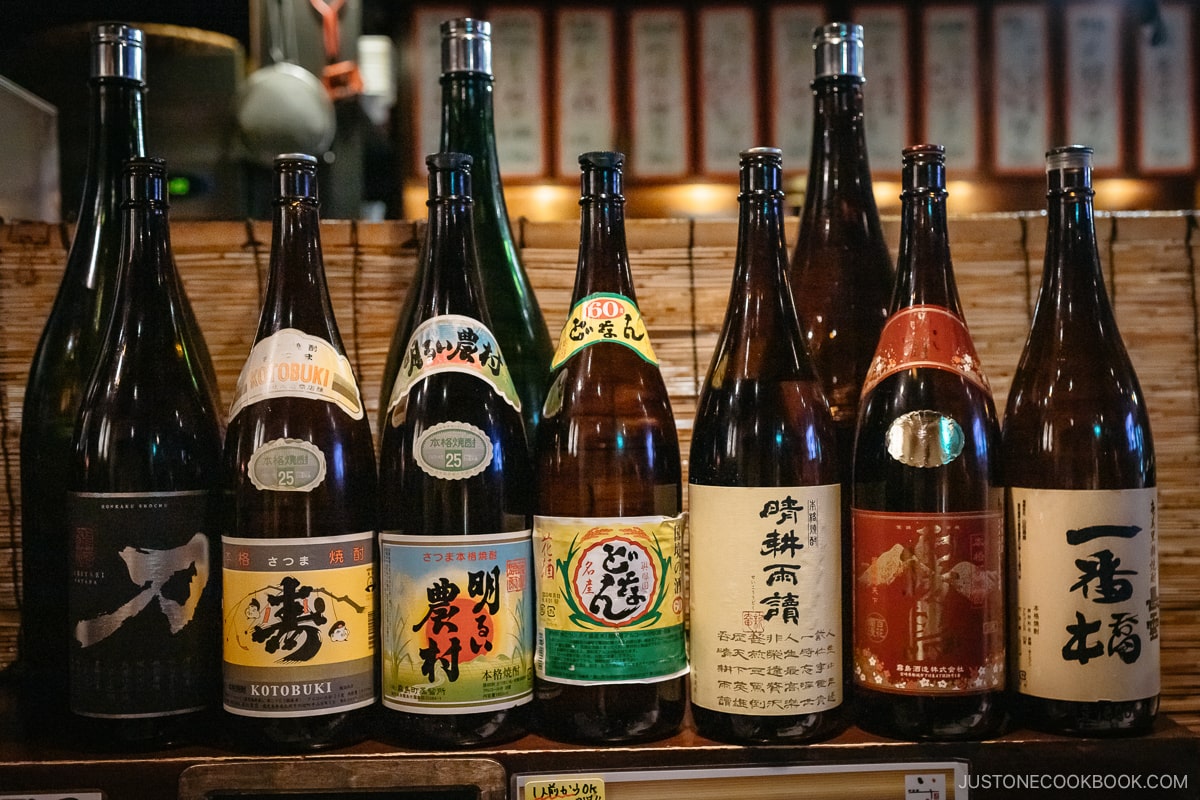
Wondering what to drink at an izakaya? While there’s no pressure to order an alcoholic beverage, you may be asked to order at least one drink during your stay. A typical izakaya would offer a range of sake and shochu (Japanese distilled alcohol) from across the country as well as beer, highballs, cocktails/chuhai, sours, wine, whiskey, and non-alcoholic drinks like juice, cold teas, soda, and soft drinks.
The Japanese usually start with a round of beer, then go to the heavy stuff like sake, whiskey, and shochu. There are no rules to drink pairings, so feel free to order what you desire!
🍹 Japanese Yuzu Cocktail, Japanese Plum Wine, Aka Shiso Juice, and Buckwheat Tea recipes on JOC.
🍶 For more about sake, read Sake Guide for Beginners and How to Enjoy Sake (Food Pairings Included).
Izakaya Culture in the US
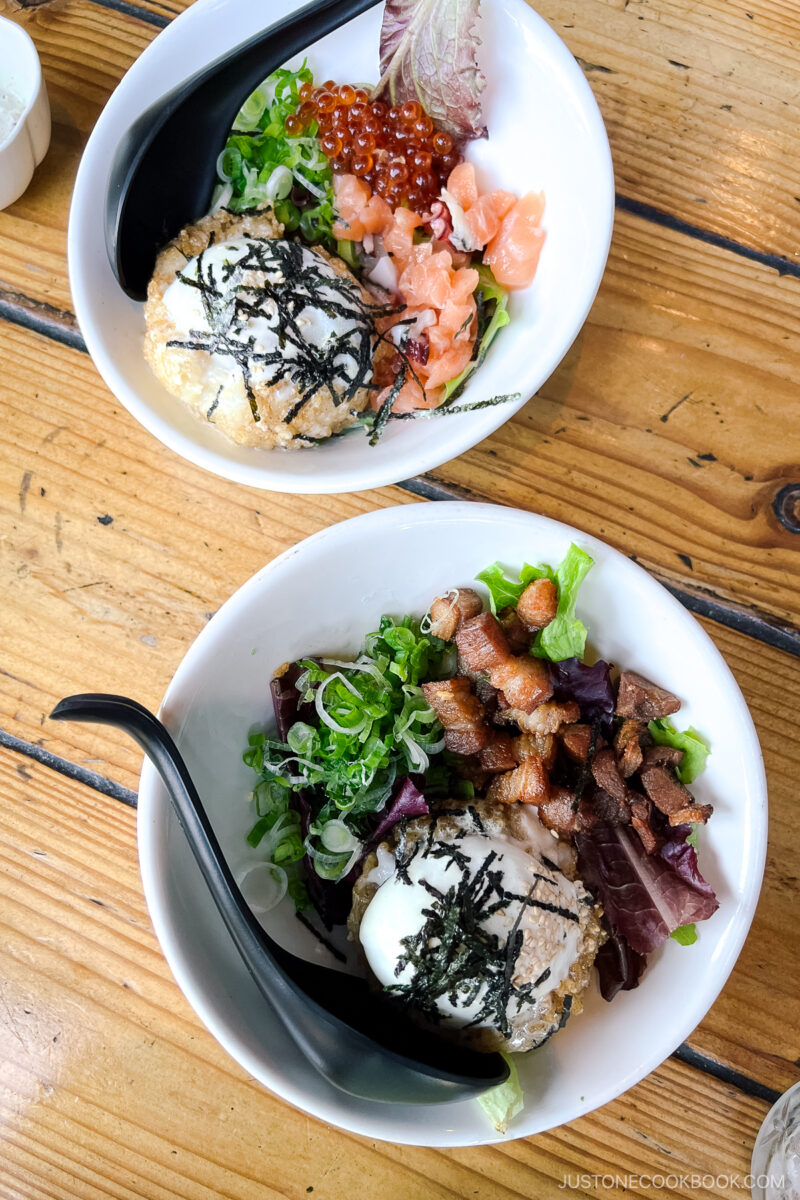
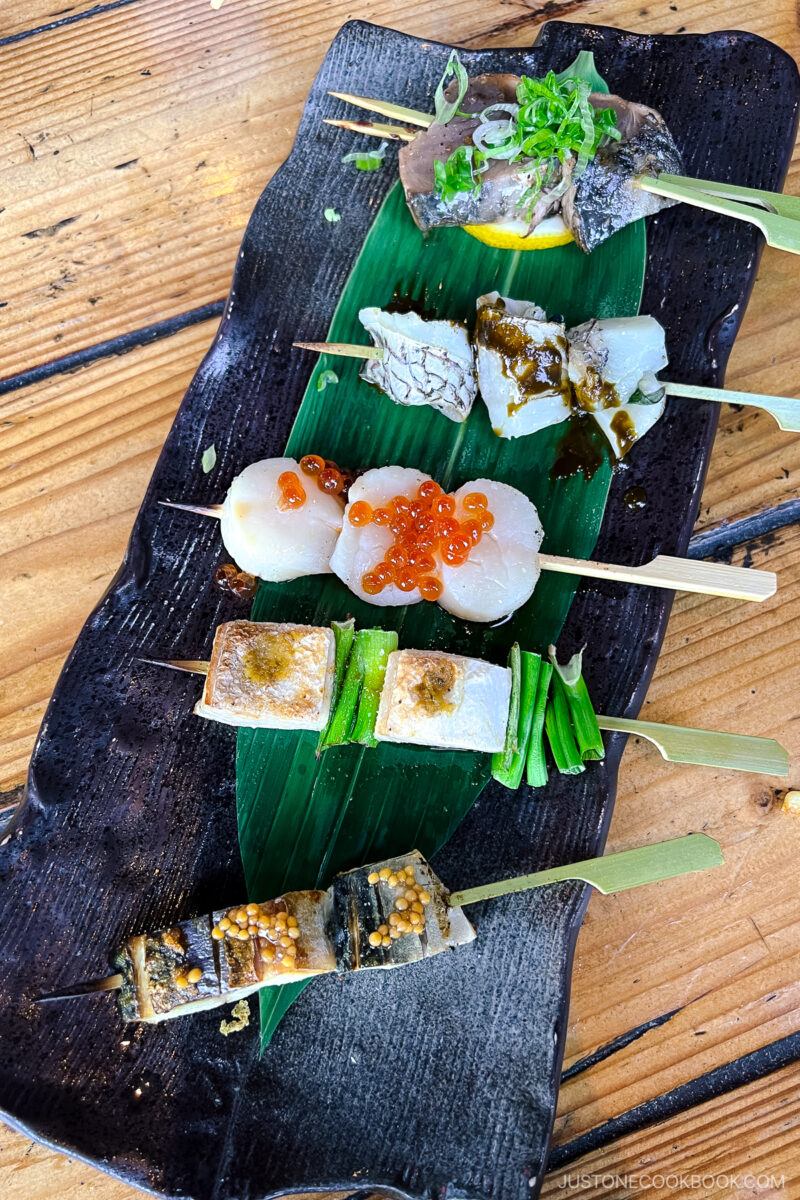
In the US, izakayas started becoming more common in the late 2000s. As the awareness of Japanese food increased, authentic izakayas that served yakitori and other popular dishes started appearing. Similar to izakayas in Japan, the atmosphere is typically fun and loud.
However, compared to izakayas in Japan, the variety of food and drinks is not as plentiful. The US izakayas are typically more meat-focused vs. seafood-focused menu in Japan. Often featuring fresh catch from various ports around Japan. Lastly, the price of izakaya in the US is also quite expensive. Whereas Japan’s izakaya are largely affordable places where co-workers and friends can gather.
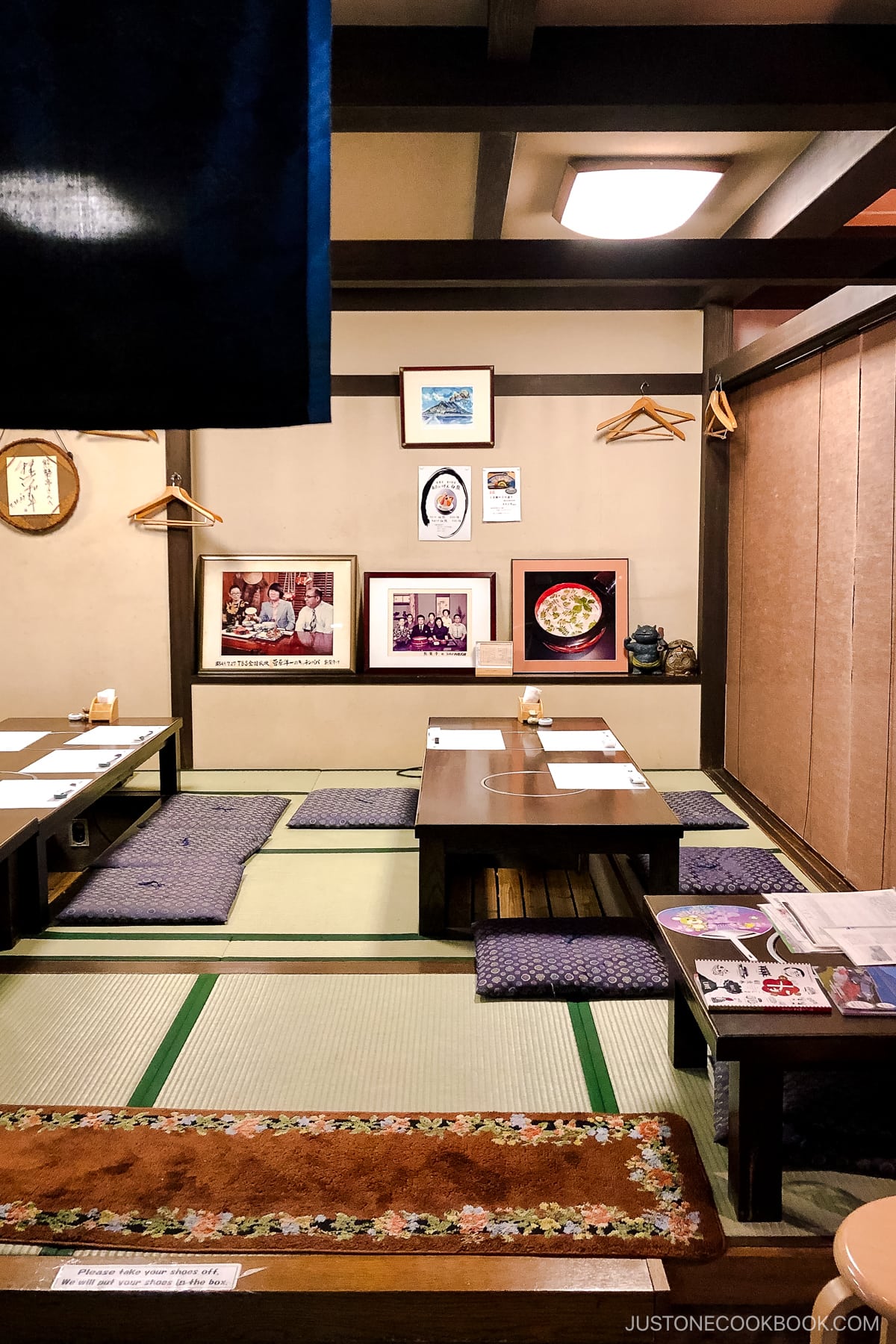
Check Out an Izakaya During Your Japan Travel!
Izakayas offers a warm and welcoming environment where people can relax with delicious food, savor various drinks, and engage in lively conversations. For visitors to Japan, experiencing izakaya culture is an excellent way to immerse yourself in the local customs and social life of the country.
While it’s impossible to recommend the best izakaya due to the sheer volume scattered across the country and new establishments constantly popping up, remember that it’s a space where friends and strangers gather to eat, drink, and be merry over good food and drinks. Following locals to their favorite neighborhood watering holes or asking local friends for recommendations is the best way to find an izakaya.
Curious to learn more about izakaya culture? Read more about the JOC family’s experience at an izakaya.
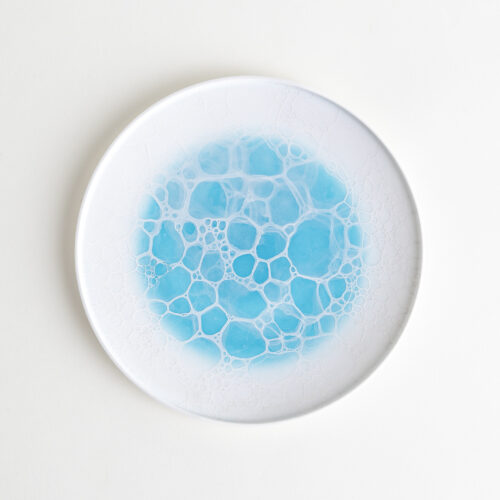
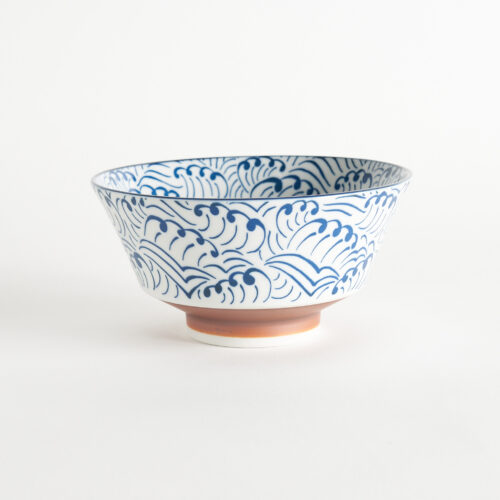
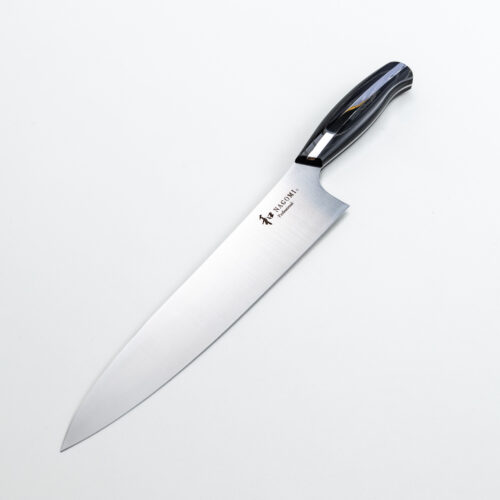
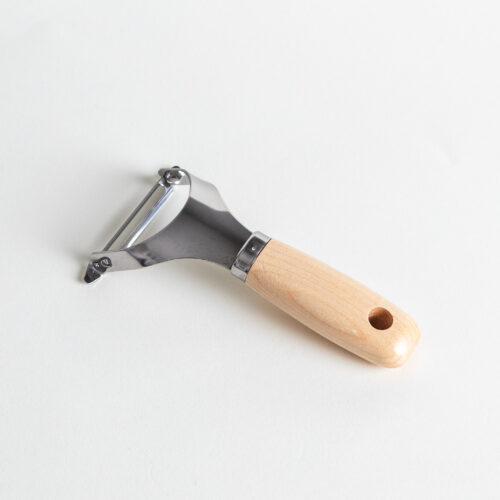
is it acceptable to go to an izakaya for drinks only? or drinks and just one small otsumami to share?
Hi Ethan! It should be fine to go in just for drinks. Many customers drop by izakaya for their second or third round of drinks for the night as well, so it should not be an issue. Hope you enjoy!
Traveling with a small group we went to izakaya in Takayama and Kyoto. Both were loads of fun and in one the Japanese salarymen next to us (who were feeling no pain) invivted us to the “party” – both places focued on yakatori and grilled items. quite a lot of fun. Bob G.
Hi Bob, that must have been a fantastic experience! Glad you enjoyed your izakaya experience in Japan 🙂
Is it frowned upon to take younger kids (elementary and preschool age) with you to an izakaya in Japan?
Hi Steph, to answer your question, no it’s not frowned upon to take younger kids to an izakaya, but I would use some common sense, for example, going early to avoid the rowdy post-work crowd (7-8 PM), checking in advance if the place is non-smoking, avoiding izakaya in business districts (in Tokyo that would be Shinjuku, Ikebukuro, Kanda/Akihabara/Tokyo, etc). Some izakaya have tatami mat seating, which may be friendlier for little kiddies, who might get tired of sitting in chairs and want space to wiggle around. Good luck!
That’s interesting, Kayoko. Good to know that ordering alcoholic drinks is not an absolute requirement as the only one I can tolerate is umeshu and not even a full glass of it.
Husband and I went to an all-chicken izakaya in Tokyo in Nov 2022. https://maps.app.goo.gl/h2PeRxWKkE8pwqFK9
They served all the different parts of the chicken in skewers, including this undeveloped egg, still attached to whatever (pic attached if I managed to do it right), as well as raw chicken. Yep, that would be the only restaurant we’d feel safe to eat raw chicken.
We love the concept and atmosphere of izakayas. The only problem is the language barrier so we can’t even join in on any conversation. If only I could communicate in any language… that would be the superpower I want.
Somehow my comment wouldn’t post if I attached a pic. So here’s a link to the pic
https://drive.google.com/file/d/1JjCfq6caqtlJcqjxMW-ed2_hkFm2-N9v/view?usp=drivesdk
Hi Sunflowii, thanks for reading!
Yes, there are lots of izakaya specializing in chicken, and I would also feel safe trying raw chicken at places that source their produce directly from the source. The undeveloped egg is called Kinkan (キンカン), which is super high in protein. Glad you enjoyed your Japan trip!
Delightful read! Thank you for taking me on this delicious journey.
I was actually just conversing with my spouse over dinner tonight (Nami’s baked chicken katsu (https://www.justonecookbook.com/crispy-baked-chicken/) :D) about a highlight of our trip to Vancouver, Canada last year: an izakaya called Guu. I really resonated with what you said about the difference between American and Japanese izakaya, and I know that CA isn’t America, but wow was I blown away by how similar it was to experiences I had in Japan. We ended up going there 4 times during our 10 day stay!
I still cook dishes that I had while there, like the daikon salad with ume (https://www.justonecookbook.com/daikon-salad-radish-salad/). And I think often about the ham katsu (https://www.justonecookbook.com/ham-katsu/) and I really just need to make that recipe one of these days though I don’t fry much.
Can’t wait to do it all over again! And keep posting the great articles. Thank you!
Hi John, thank you for reading! You really must have loved your izakaya experience in Vancouver!
Glad you have recreated the experience at home 🙂
Guu is so, so good! I have only been there once but I would love to go back, but don’t get to Vancouver often.
Kayako, thank you so much for this informative article. I am going to Japan very soon and it has been very helpful! 🙂
Hi Alyssa, thanks for reading and hope you enjoy your Japan trip!